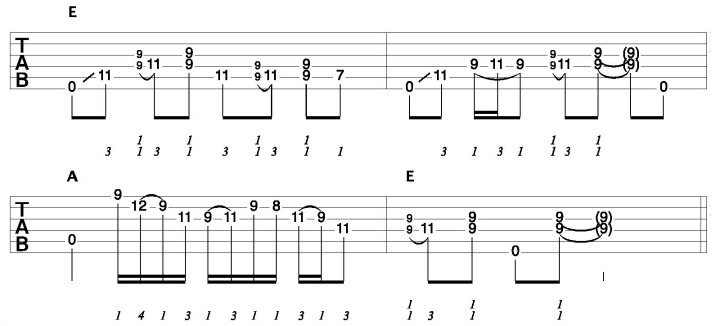Acoustic Guitar Licks - Making Use Of Open Strings On Your Guitar
Today I would like to show you a great way you can use open strings on your guitar to really bring your licks to life. We have touched on this in a previous email, but it is definitely worth exploring further. It is such a simple, but very effective way of having your acoustic guitar riffs sound so much better when you are playing them on your own, without any one else playing along with you.
Open strings on the guitar are most commonly used in the open position. The open position consists of the open strings and the first 3 frets. You will of course find them in the open chords, as well as licks and melodies that are played in this area.
Only using open strings on your guitar in this way however, is a waste, as there are so many other ways in which you can use them to really bring your acoustic guitar playing to life.
Listen to the pentatonic scale below:

Sounds ok, but it would sound much better, and more musical if it had some kind of context to it. Using open strings on your guitar is the answer here.
Have a listen to it now:

* I have left out the lower string of the scale to allow the open E to ring throughout
How much better does that sound?
And all I did was play a low open E string at the beginning and end of my scale. This gives the notes a musical context.
Here is the same scale, only this time I play the open A string at the beginning and again at the end:
 * I have left out the lower 2 strings of the scale to allow the open A to ring throughout
* I have left out the lower 2 strings of the scale to allow the open A to ring throughout
Notice how my scale now sounds different. This is because the notes are being sounded out on top of a different bass note, in this case the open A string of the guitar. The notes of my scale relate differently to this A note as they did to the E note.
Droning Open Strings With Licks On Your Acoustic Guitar
Now lets dig in and actually create some acoustic licks on the guitar utilizing the open strings as we did with our pentatonic scale above.
The following two licks make use of the low open E string on your guitar. I have both a recording of the lick with the open string included and without. This way you can hear the difference it makes:


Here are another two licks, also from the pentatonic scale, that use the open A string. Again I have included both a recording with the open string and without it because I really want you to hear the difference this simple idea can make:


You will often here this approach referred to as “droning” open strings, simply because the sound of the open string drones out as you play your guitar lick.
The open strings are actually implying a chord when you do this and is why the E and A chords appear above the tabs in the examples given so far. It is almost like someone is playing either the E or A chord as you play your lick.
Lets take this idea one step further by creating or implying a chord progression as we play our licks on the guitar. This chord progression is going to consist of, you guessed it, E and A.
Here it is:

And here is our little arrangement of guitar licks, pretty much based off the ones that we have played so far, while we imply the above chord progression with our low E and A open strings on the guitar:

In the above example, I need to make sure that I drone the low E open string for bars 1, 2, and 4 and the A open string for bar 3 so that I follow the chord progression that I am implying as I play my licks.
Using a droning open string approach with the licks you play on your guitar has a very cool effect. It has what you play sound more complete when you are playing your guitar on your own.
As always be sure to experiment with this approach, the possibilities are almost endless in what you can do.
Learn how to get started fingerpicking guitar with online fingerpicking lessons for beginners